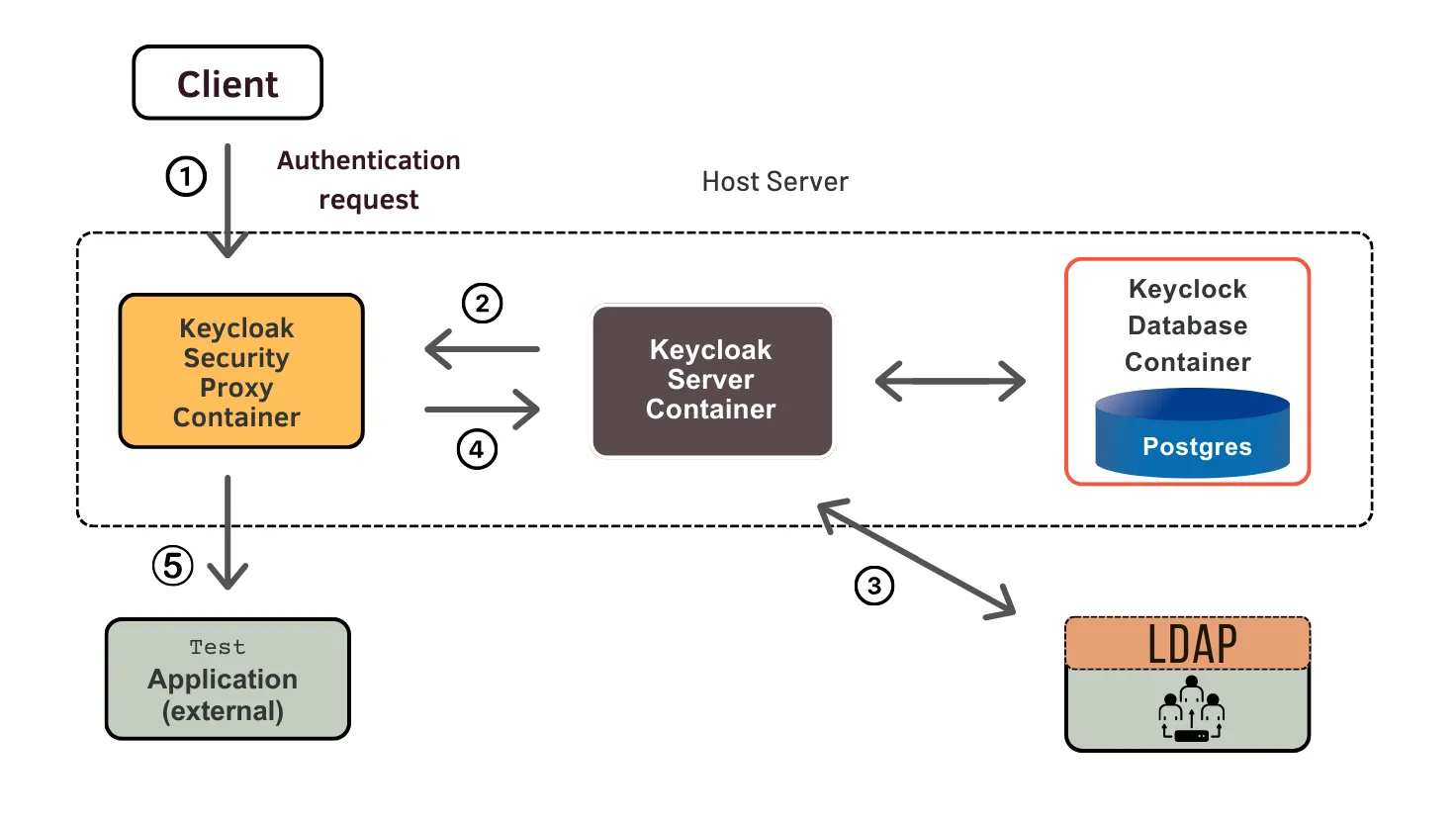February 18, 2025
Complete Guide to Implementing OAuth2 Authorization with Keycloak and Gatekeeper for Kubernetes Deployments

By Rakshit Menpara
Improwised Technologies Pvt. Ltd.
A Look at OAuth2 with Keycloak

Modern microservices architectures require robust authentication and permission mechanisms to ensure the security of distributed applications. Keycloak’s OAuth2 authorization provides enterprise-level identity and access management (IAM) tools that work seamlessly with containerized systems.
Keycloak is one of the most complete open-source identity providers available today. It was made by the Red Hat JBoss community. It employs OpenID Connect (OIDC), OAuth 2.0, and SAML 2.0, which are all industry standards. This makes it an excellent choice for enterprises that want to manage authentication from one place without being bound to a single provider.
What Makes This Guide Unique
This detailed guide goes over more than just the basics. It also has production-ready ways to set up Kubernetes OAuth2 authentication, ways to make security stronger, and ways to make performance better that are made just for these situations.
Why Choose Keycloak Gatekeeper for Kubernetes?
What is the Keycloak Gatekeeper?
Keycloak Gatekeeper, now known as Louketo Proxy, is a simple authentication proxy that sits between your apps and users. It uses OAuth2 to control access without you having to update the code of your current services.
Container orchestration has a lot of benefits, such as:
Simplified Integration: As a sidecar proxy, Gatekeeper may authenticate any HTTP-based service, regardless of the programming language or framework it uses. This is not like regular authentication libraries, which need changes to the application level.
Design that works with Kubernetes: Gatekeeper was designed to work with cloud-native systems, and it works great with Kubernetes ingress controllers, service meshes, and container networking.
The Zero-Trust Security Model: Keycloak employs defense-in-depth to make sure that security is constantly enforced across your microservices ecosystem by evaluating every request against its centralized policy engine.
Comparison with Alternatives
| Feature | Keycloak Gatekeeper | Istio | Ambassador | Traefik |
|---|---|---|---|---|
| Learning Curve | Low | High | Medium | Medium |
| Keycloak Integration | Native | Plugin Required | Plugin Required | Plugin Required |
| Resource Usage | Minimal | High | Medium | Low |
| Configuration Complexity | Simple YAML | Complex CRDs | Medium | Simple |
Prerequisites and System Requirements
Technical Requirements
- Kubernetes Cluster: Version 1.19+ with RBAC enabled
- Keycloak Server: Version 15.0+ (standalone or containerized)
- Ingress Controller: NGINX, Traefik, or HAProxy compatible
- SSL/TLS Certificates: Valid certificates for production deployments
- Resource Allocation: Minimum 512MB RAM and 0.5 CPU cores per Gatekeeper instance
Knowledge Prerequisites
- Basic understanding of OAuth2 authorization flows
- Familiarity with Kubernetes deployments and services
- Experience with YAML configuration management
- Understanding of JWT token structure and validation
Setting Up Keycloak Server
Prerequisites: A PostgreSQL database
Kubernetes Keycloak Deployment
For production environments, deploy Keycloak on Kubernetes with high availability:
# keycloak-deployment.yaml
apiVersion: apps/v1
kind: Deployment
metadata:
name: keycloak
namespace: improwised-auth
labels:
app: keycloak
version: "22.0"
spec:
replicas: 2
selector:
matchLabels:
app: keycloak
template:
metadata:
labels:
app: keycloak
spec:
containers:
- name: keycloak
image: quay.io/keycloak/keycloak:22.0
env:
- name: KC_DB
value: postgres
- name: KC_DB_URL
value: jdbc:postgresql://postgres-service:5432/keycloak
- name: KC_DB_USERNAME
valueFrom:
secretKeyRef:
name: keycloak-db-secret
key: username
- name: KC_DB_PASSWORD
valueFrom:
secretKeyRef:
name: keycloak-db-secret
key: password
- name: KC_HOSTNAME
value: auth.improwised.com
- name: KC_PROXY
value: edge
ports:
- containerPort: 8080
name: http
readinessProbe:
httpGet:
path: /realms/master
port: 8080
initialDelaySeconds: 60
periodSeconds: 10
livenessProbe:
httpGet:
path: /realms/master
port: 8080
initialDelaySeconds: 90
periodSeconds: 30
resources:
requests:
memory: "1Gi"
cpu: "500m"
limits:
memory: "2Gi"
cpu: "1000m"#keycloak-service.yaml
apiVersion: v1
kind: Service
metadata:
name: keycloak-service
namespace: improwised-auth
labels:
app: keycloak
spec:
selector:
app: keycloak
ports:
- name: http
port: 80
targetPort: 8080
type: ClusterIP# keycloak-ingress.yaml
apiVersion: networking.k8s.io/v1
kind: Ingress
metadata:
name: keycloak-ingress
namespace: improwised-auth
spec:
ingressClassName: nginx
tls:
- hosts:
- auth.improwised.com
rules:
- host: auth.improwised.com
http:
paths:
- path: /
pathType: Prefix
backend:
service:
name: keycloak-service
port:
number: 80Realm and Client Configuration
Setting Up Authentication in Keycloak
1. Create a New Realm
- Open the Keycloak Admin Console in your browser:
- Log in with your admin account.
- Click “Add Realm” and create a new one named
improwised-production.
This realm will act as a security boundary for your production environment.
2. Add a New Client
A client in Keycloak represents an application that uses Keycloak to handle login and security.
-
Go to Clients → Create
-
Enter the following details:
- Client ID:
improwised-gatekeeper-client - Protocol:
openid-connect
- Client ID:
-
Once created, go to the Settings tab and configure:
- Redirect URLs:
- Web Origins:
- https://*.improwised.com
-
Under Advanced Settings, set:
- Access token lifespan: 30 minutes (1800 seconds)
- Session timeout: 1 hour (3600 seconds)
3. Enable Service Account
Enable the Service Account feature for this client.
This allows secure, automated communication between services — for example, backend-to-backend authentication — without needing a user to log in manually.
4. Add Custom User Information (Token Mappers)
To include user group details in tokens (useful for permissions or role checks), add a Custom Token Mapper:
-
Go to Client → Mappers → Create
-
Fill in the following:
- Name:
improwised-groups - Mapper Type:
Group Membership - Token Claim Name:
groups - Enable:
- Add to ID Token
- Add to Access Token
- Set Full Path:
false
- Name:
Configuring Keycloak Gatekeeper
Basic Gatekeeper Configuration
Create a comprehensive configuration file for Keycloak Gatekeeper:
# gatekeeper-config-configmap.yaml
apiVersion: v1
kind: ConfigMap
metadata:
name: gatekeeper-config
namespace: production
data:
gatekeeper-config.yaml: |
# Keycloak connection settings
discovery-url: https://auth.improwised.com/realms/improwised-production/.well-known/openid-configuration
client-id: improwised-gatekeeper-client
client-secret: ${KEYCLOAK_CLIENT_SECRET}
# Security settings
encryption-key: ${ENCRYPTION_KEY} # 32-byte base64 encoded key
secure-cookie: true
same-site-cookie: strict
enable-security-filter: true
enable-https-redirection: true
# Application settings
listen: 0.0.0.0:3000
upstream-url: http://improwised-backend-service:8080
upstream-keepalives: true
upstream-timeout: 30s
# Redirect configuration
redirection-url: https://api.improwised.com
post-logout-redirect-url: https://improwised.com/logout-success
# Session management
enable-session-cookies: true
cookie-domain: .improwised.com
cookie-access-name: improwised-access-token
cookie-refresh-name: improwised-refresh-token
store-url: redis://redis-service:6379/0
# Resource protection rules
resources:
# Public endpoints (no authentication required)
- uri: /health
white-listed: true
- uri: /metrics
white-listed: true
- uri: /api/v1/public/*
white-listed: true
# Protected admin endpoints
- uri: /api/v1/admin/*
methods:
- GET
- POST
- PUT
- DELETE
roles:
- improwised:admin
- improwised:super-admin
# Protected user endpoints
- uri: /api/v1/user/*
methods:
- GET
- POST
roles:
- improwised:user
- improwised:admin
# File upload endpoints with size restrictions
- uri: /api/v1/upload/*
methods:
- POST
roles:
- improwised:user
headers:
Content-Length: "50000000" # 50MB limit
# Logging and monitoring
enable-logging: true
enable-metrics: true
enable-profiling: true
# CORS configuration
cors-origins:
- "https://app.improwised.com"
- "https://admin.improwised.com"
cors-methods:
- GET
- POST
- PUT
- DELETE
- OPTIONS
cors-headers:
- Authorization
- Content-Type
- X-Requested-WithAdvanced Security Configuration for Gatekeeper
For production environments, implement additional security measures at the existing configuration:
# gatekeeper-config-configmap.yaml
apiVersion: v1
kind: ConfigMap
metadata:
name: gatekeeper-security-extension
namespace: production
data:
gatekeeper-extra.yaml: |
# Additional security headers
headers:
X-Frame-Options: DENY
X-Content-Type-Options: nosniff
X-XSS-Protection: "1; mode=block"
Strict-Transport-Security: "max-age=31536000; includeSubDomains"
Content-Security-Policy: "default-src 'self'"
# Token validation settings
skip-token-verification: false
skip-access-token-clientid-check: false
enable-token-header: true
skip-authorization-header-identity: true
# Upstream headers
response-headers:
X-Auth-Audience: audience
X-Auth-Email: email
X-Auth-ExpiresIn: exp
X-Auth-Groups: groups
X-Auth-Roles: realm_access.roles
X-Auth-Subject: sub
X-Auth-Token: access_token
X-Auth-Userid: preferred_username
# Request filtering
enable-request-id: true
request-id-header: X-Request-ID
enable-compression: trueService and ConfigMap Resources
Complete the deployment with supporting resources:
# gatekeeper-secret,yaml
apiVersion: v1
kind: Secret
metadata:
name: keycloak-secrets
namespace: production
type: Opaque
data:
client-secret: <base64-encoded-client-secret>
encryption-key: <base64-encoded-32-byte-key>
# application-service.yaml
apiVersion: v1
kind: Service
metadata:
name: improwised-app-service
namespace: production
spec:
selector:
app: improwised-app
ports:
- name: http
port: 80
targetPort: 3000 # Gatekeeper port
- name: metrics
port: 9090
targetPort: 9090
type: ClusterIPKubernetes Integration Strategies
Sidecar Proxy Deployment Pattern
Deploy Gatekeeper as a sidecar container for fine-grained control:
# sidecar-deployment.yaml
apiVersion: apps/v1
kind: Deployment
metadata:
name: improwised-app-with-auth
namespace: production
spec:
replicas: 3
selector:
matchLabels:
app: improwised-app
template:
metadata:
labels:
app: improwised-app
spec:
containers:
# Main application container
- name: improwised-backend
image: improwised/backend-api:v1.2.3
ports:
- containerPort: 8080
env:
- name: AUTH_ENABLED
value: "false" # Auth handled by sidecar
resources:
requests:
memory: "512Mi"
cpu: "250m"
limits:
memory: "1Gi"
cpu: "500m"
# Keycloak Gatekeeper sidecar
- name: auth-proxy
image: quay.io/gogatekeeper/gatekeeper:1.3.0
ports:
- containerPort: 3000
env:
- name: KEYCLOAK_CLIENT_SECRET
valueFrom:
secretKeyRef:
name: keycloak-secrets
key: client-secret
- name: ENCRYPTION_KEY
valueFrom:
secretKeyRef:
name: keycloak-secrets
key: encryption-key
volumeMounts:
- name: gatekeeper-config
mountPath: /etc/gatekeeper
readOnly: true
args:
- "--config=/etc/gatekeeper/config.yaml"
resources:
requests:
memory: "128Mi"
cpu: "100m"
limits:
memory: "256Mi"
cpu: "200m"
livenessProbe:
httpGet:
path: /oauth/health
port: 3000
initialDelaySeconds: 30
periodSeconds: 10
readinessProbe:
httpGet:
path: /oauth/health
port: 3000
initialDelaySeconds: 5
periodSeconds: 5
volumes:
- name: gatekeeper-config
configMap:
name: gatekeeper-config
# Security context
securityContext:
runAsNonRoot: true
runAsUser: 1000
fsGroup: 2000Production Deployment Considerations
High Availability Setup
When deploying to production, you’ll want to ensure your authentication infrastructure can handle real-world traffic patterns and provide uninterrupted service. Here’s how we typically approach this challenge:
Session Storage Configuration
For production environments, centralized session storage becomes critical:
# redis-cluster-statefulset.yaml
apiVersion: apps/v1
kind: StatefulSet
metadata:
name: redis-cluster
spec:
serviceName: redis-cluster
replicas: 7
selector:
matchLabels:
app: redis-cluster
template:
metadata:
labels:
app: redis-cluster
spec:
affinity:
podAntiAffinity:
preferredDuringSchedulingIgnoredDuringExecution:
- weight: 100
podAffinityTerm:
labelSelector:
matchExpressions:
- key: app
operator: In
values:
- redis-cluster
topologyKey: kubernetes.io/hostname
containers:
- name: redis
image: redis:6.2.5
command: ['redis-server']
args: ['/conf/redis.conf']
env:
- name: REDIS_CLUSTER_ANNOUNCE_IP
valueFrom:
fieldRef:
fieldPath: status.podIP
ports:
- containerPort: 6379
name: client
- containerPort: 16379
name: gossip
volumeMounts:
- name: conf
mountPath: /conf
- name: data
mountPath: /data
volumes:
- name: conf
configMap:
name: redis-config
volumeClaimTemplates:
- metadata:
name: data
spec:
accessModes: ['ReadWriteOnce']
resources:
requests:
storage: 10Gi# redis-cluster-configmap.yaml
apiVersion: v1
kind: ConfigMap
metadata:
name: redis-config
data:
redis.conf: |
bind 0.0.0.0
port 6379
cluster-enabled yes
cluster-config-file nodes.conf
cluster-node-timeout 5000
appendonly yes
dir /data
protected-mode noPerformance Optimization and Caching For Gatekeeper
Update Your ConfigMap before Deploying Gatekeeper
Next, add the following section to the ConfigMap gatekeeper-config-configmap.yaml you created earlier. This will extend your configuration settings:
# Enhanced gatekeeper configuration with caching
store-url: redis://redis-cluster:6379/0
enable-session-cookies: true
access-token-duration: 15m
# Token caching configuration
enable-token-header: true
enable-authorization-cookie: true
enable-encrypted-token: true
# Upstream connection pooling
upstream-keepalives: true
upstream-keepalive-timeout: 60s
upstream-response-header-timeout: 30sGatekeeper Setup
# ha-gatekeeper-deployment.yaml
apiVersion: apps/v1
kind: Deployment
metadata:
name: gatekeeper-ha
namespace: production
spec:
replicas: 5
strategy:
type: RollingUpdate
rollingUpdate:
maxUnavailable: 1
maxSurge: 2
selector:
matchLabels:
app: gatekeeper
template:
metadata:
labels:
app: gatekeeper
spec:
affinity:
podAntiAffinity:
preferredDuringSchedulingIgnoredDuringExecution:
- weight: 100
podAffinityTerm:
labelSelector:
matchExpressions:
- key: app
operator: In
values:
- gatekeeper
topologyKey: kubernetes.io/hostname
containers:
- name: gatekeeper
image: quay.io/gogatekeeper/gatekeeper:1.3.0
resources:
requests:
memory: "256Mi"
cpu: "200m"
limits:
memory: "512Mi"
cpu: "500m"
volumeMounts:
- name: gatekeeper-config
mountPath: /etc/gatekeeper
readOnly: true
readinessProbe:
httpGet:
path: /oauth/health
port: 3000
initialDelaySeconds: 10
periodSeconds: 5
timeoutSeconds: 3
failureThreshold: 3
livenessProbe:
httpGet:
path: /oauth/health
port: 3000
initialDelaySeconds: 30
periodSeconds: 10
timeoutSeconds: 5
failureThreshold: 3
volumes:
- name: gatekeeper-config
configMap:
name: gatekeeper-configDeployment with NGINX Ingress Controller
Implement OAuth2 authentication using NGINX ingress annotations:
# nginx-ingress-oauth2.yaml
apiVersion: networking.k8s.io/v1
kind: Ingress
metadata:
name: improwised-protected-ingress
namespace: production
annotations:
kubernetes.io/ingress.class: nginx
nginx.ingress.kubernetes.io/force-ssl-redirect: "true"
# OAuth2 Authentication
nginx.ingress.kubernetes.io/auth-url: "https://auth.improwised.com/oauth/authorize"
nginx.ingress.kubernetes.io/auth-signin: "https://auth.improwised.com/oauth/start?rd=$escaped_request_uri"
nginx.ingress.kubernetes.io/auth-response-headers: "X-Auth-Request-User,X-Auth-Request-Email,X-Auth-Request-Groups"
# Additional security headers
nginx.ingress.kubernetes.io/configuration-snippet: |
more_set_headers "X-Frame-Options: DENY";
more_set_headers "X-Content-Type-Options: nosniff";
more_set_headers "X-XSS-Protection: 1; mode=block";
spec:
tls:
- hosts:
- api.improwised.com
secretName: improwised-tls-secret
rules:
- host: api.improwised.com
http:
paths:
- path: /
pathType: Prefix
backend:
service:
name: improwised-backend-service
port:
number: 8080JWT Token Management and Validation
Understanding JWT Structure in Keycloak
Keycloak issues JWTs with specific claims that Gatekeeper validates. Understanding the token structure is crucial for debugging and custom authorization logic:
{
"header": {
"alg": "RS256",
"typ": "JWT",
"kid": "keycloak-key-id"
},
"payload": {
"exp": 1694441234,
"iat": 1694439434,
"auth_time": 1694439434,
"jti": "uuid-token-identifier",
"iss": "https://auth.improwised.com/realms/improwised-production",
"aud": ["improwised-gatekeeper-client", "account"],
"sub": "user-uuid",
"typ": "Bearer",
"azp": "improwised-gatekeeper-client",
"session_state": "session-uuid",
"acr": "1",
"scope": "openid email profile",
"email_verified": true,
"name": "John Doe",
"preferred_username": "john.doe",
"given_name": "John",
"family_name": "Doe",
"email": "john.doe@improwised.com",
"groups": ["improwised:user", "improwised:developer"],
"realm_access": {
"roles": ["default-roles-improwised-production", "offline_access", "uma_authorization"]
},
"resource_access": {
"improwised-gatekeeper-client": {
"roles": ["user", "developer"]
}
}
}
}Custom JWT Validation Logic
For applications requiring custom token validation beyond Gatekeeper’s capabilities:
# jwt_validator.py - Custom JWT validation for Improwised applications
import jwt
from jwt import PyJWKClient
import requests
import logging
from datetime import datetime, timedelta
from typing import Dict, List, Optional
from functools import lru_cache
class ImprowisedJWTValidator:
"""Enhanced JWT validator for Improwised microservices"""
def __init__(self, keycloak_url: str, audience: str, realm: str, client_id: str):
self.keycloak_url = keycloak_url
self.realm = realm
self.client_id = client_id
self.audience = audience
self.logger = logging.getLogger(__name__)
@lru_cache(maxsize=1)
def validate_token(self, token: str, required_roles: List[str] = None) -> Dict:
"""
Comprehensive token validation with role checking
Args:
token: JWT token string
required_roles: List of required roles for authorization
Returns:
Decoded token payload if valid
Raises:
jwt.InvalidTokenError: If token is invalid
PermissionError: If user lacks required roles
"""
try:
# Decode header to get key ID
header = jwt.get_unverified_header(token)
key_id = header.get('kid')
print(key_id)
if not key_id:
raise jwt.InvalidTokenError("Token missing key ID")
# Get public key for verification
jwks_url = f"{self.keycloak_url}/realms/{self.realm}/protocol/openid-connect/certs"
public_key = PyJWKClient(jwks_url).get_signing_key_from_jwt(token).key
print(public_key)
# Verify and decode token
payload = jwt.decode(
token,
public_key,
algorithms=['RS256'],
audience=self.audience,
issuer=f"{self.keycloak_url}/realms/{self.realm}",
options={
"verify_signature": True,
"verify_exp": True,
"verify_iat": True,
"verify_aud": True,
"verify_iss": True
}
)
print("verified")
# Validate token freshness (additional security check)
auth_time = payload.get('auth_time')
if auth_time:
auth_datetime = datetime.fromtimestamp(auth_time)
max_age = timedelta(hours=8) # Configurable max session age
if datetime.now() - auth_datetime > max_age:
raise jwt.InvalidTokenError("Token authentication too old")
# Check required roles if specified
if required_roles:
user_roles = self._extract_user_roles(payload)
missing_roles = set(required_roles) - set(user_roles)
if missing_roles:
raise PermissionError(f"Missing required roles: {missing_roles}")
# Log successful validation for audit
username = payload.get('preferred_username', 'unknown')
self.logger.info(f"Token validated successfully for user: {username}")
return payload
except jwt.ExpiredSignatureError:
self.logger.warning("Token has expired")
raise
except jwt.InvalidAudienceError:
self.logger.warning("Token audience mismatch")
raise
except jwt.InvalidIssuerError:
self.logger.warning("Token issuer mismatch")
raise
except Exception as e:
self.logger.error(f"Token validation failed: {e}")
raise
def _extract_user_roles(self, payload: Dict) -> List[str]:
"""Extract all user roles from token payload"""
roles = []
# Extract realm roles
realm_access = payload.get('realm_access', {})
roles.extend(realm_access.get('roles', []))
# Extract client roles
resource_access = payload.get('resource_access', {})
client_access = resource_access.get(self.client_id, {})
roles.extend(client_access.get('roles', []))
# Extract groups (if mapped as roles)
groups = payload.get('groups', [])
roles.extend(groups)
return list(set(roles)) # Remove duplicates
def refresh_token(self, refresh_token: str) -> Dict:
"""Refresh access token using refresh token"""
try:
token_url = f"{self.keycloak_url}/realms/{self.realm}/protocol/openid-connect/token"
data = {
'grant_type': 'refresh_token',
'refresh_token': refresh_token,
'client_id': self.client_id
}
response = requests.post(token_url, data=data, timeout=10)
response.raise_for_status()
return response.json()
except requests.RequestException as e:
self.logger.error(f"Token refresh failed: {e}")
raise# Usage example
def validate_request_token(request_headers: Dict, required_roles: List[str] = None) -> Dict:
"""Validate JWT token from HTTP request headers"""
auth_header = request_headers.get('Authorization', '')
if not auth_header.startswith('Bearer '):
raise ValueError("Missing or invalid Authorization header")
token = auth_header[7:] # Remove 'Bearer ' prefix
validator = ImprowisedJWTValidator(
keycloak_url="https://auth.improwised.com",
realm="improwised-production",
client_id="improwised-gatekeeper-client",
audience="user"
)
return validator.validate_token(token, required_roles)
# Flask application example
from flask import Flask, request, jsonify
app = Flask(__name__)
@app.route("/")
def home():
return jsonify({"message": "Flask is running!"})
@app.route('/api/v1/secure-endpoint')
def secure_endpoint():
"""Example secured endpoint with role-based access control"""
try:
# Validate token and check for admin role
payload = validate_request_token(
request.headers,
required_roles=['improwised:admin']
)
return jsonify({
'message': 'Access granted',
'user': payload.get('preferred_username'),
'roles': payload.get('groups', [])
})
except (jwt.InvalidTokenError, PermissionError) as e:
return jsonify({'error': str(e)}), 401
except Exception as e:
return jsonify({'error': 'Internal server error'}), 500
if __name__ == "__main__":
app.run(host="0.0.0.0", port=5000, debug=True)Token Introspection and Validation
For high-security environments, implement token introspection:
# Token introspection example using curl
curl -X POST \
'https://auth.improwised.com/realms/improwised-production/protocol/openid-connect/token/introspect' \
-H 'Content-Type: application/x-www-form-urlencoded' \
-d 'token=YOUR_ACCESS_TOKEN&client_id=improwised-gatekeeper-client&client_secret=YOUR_CLIENT_SECRET'Security Best Practices
Network Security Configuration
Implement comprehensive network security measures:
# network-policy.yaml - Kubernetes Network Policy for Gatekeeper
apiVersion: networking.k8s.io/v1
kind: NetworkPolicy
metadata:
name: gatekeeper-network-policy
namespace: production
spec:
podSelector:
matchLabels:
app: improwised-app
policyTypes:
- Ingress
- Egress
ingress:
# Allow traffic from ingress controller
- from:
- namespaceSelector:
matchLabels:
name: ingress-nginx
ports:
- protocol: TCP
port: 3000
# Allow traffic from monitoring
- from:
- namespaceSelector:
matchLabels:
name: monitoring
ports:
- protocol: TCP
port: 9090
egress:
# Allow DNS resolution
- to: []
ports:
- protocol: UDP
port: 53
# Allow HTTPS to Keycloak
- to:
- namespaceSelector:
matchLabels:
name: auth-system
ports:
- protocol: TCP
port: 443
# Allow Redis connection
- to:
- podSelector:
matchLabels:
app: redis
ports:
- protocol: TCP
port: 6379Secret Management Best Practices
Implement proper secret rotation and management:
# secret-rotation-cronjob.yaml
apiVersion: batch/v1
kind: CronJob
metadata:
name: rotate-gatekeeper-secrets
namespace: production
spec:
schedule: "0 2 * * 0"
jobTemplate:
spec:
template:
spec:
restartPolicy: OnFailure
containers:
- name: secret-rotator
image: bitnami/kubectl:1.27
env:
- name: KEYCLOAK_ADMIN_URL
value: "https://auth.improwised.com"
- name: KEYCLOAK_ADMIN_USER
valueFrom:
secretKeyRef:
name: keycloak-admin-secret
key: username
- name: KEYCLOAK_ADMIN_PASSWORD
valueFrom:
secretKeyRef:
name: keycloak-admin-secret
key: password
- name: CLIENT_ID
valueFrom:
secretKeyRef:
name: keycloak-client-secret
key: client-id
command: ["/bin/bash", "-c"]
args:
- |
set -euo pipefail
# Generate secret, update Keycloak & K8s secret
NEW_SECRET=$(openssl rand -base64 32)
ADMIN_TOKEN=$(curl -s -X POST "${KEYCLOAK_ADMIN_URL}/realms/master/protocol/openid-connect/token" \
-d "username=${KEYCLOAK_ADMIN_USER}" \
-d "password=${KEYCLOAK_ADMIN_PASSWORD}" \
-d 'grant_type=password' \
-d 'client_id=admin-cli' | jq -r .access_token)
kubectl patch secret keycloak-client-secret -n production \
-p "{\"data\":{\"client-secret\":\"$(echo -n ${NEW_SECRET} | base64)\"}}"
kubectl rollout restart deployment/improwised-app-with-auth -n productionSSL/TLS Configuration
Ensure end-to-end encryption with proper certificate management:
# cert-manager-issuer.yaml
apiVersion: cert-manager.io/v1
kind: ClusterIssuer
metadata:
name: letsencrypt-production
spec:
acme:
server: https://acme-v02.api.letsencrypt.org/directory
email: security@improwised.com
privateKeySecretRef:
name: letsencrypt-production
solvers:
- http01:
ingress:
class: nginxRuntime Security Monitoring
Implement comprehensive monitoring for authentication events:
# monitoring-config.yaml
apiVersion: v1
kind: ConfigMap
metadata:
name: gatekeeper-monitoring
data:
prometheus.yml: |
global:
scrape_interval: 15s
evaluation_interval: 15s
scrape_configs:
- job_name: 'gatekeeper'
static_configs:
- targets: ['gatekeeper-service:3000']
metrics_path: /metrics
- job_name: 'keycloak'
static_configs:
- targets: ['keycloak-service:8080']
metrics_path: /metrics
alerts.yml: |
groups:
- name: authentication
rules:
- alert: HighFailedLoginRate
expr: rate(gatekeeper_login_failures_total[5m]) > 10
for: 2m
labels:
severity: warning
annotations:
summary: "High authentication failure rate detected"
description: "Authentication failures have exceeded 10 per minute"
- alert: TokenValidationErrors
expr: rate(gatekeeper_token_validation_errors_total[5m]) > 5
for: 1m
labels:
severity: critical
annotations:
summary: "JWT token validation errors"
description: "Multiple token validation failures detected"Troubleshooting Common Issues
Through our experience implementing OAuth2 authentication across dozens of projects, we’ve encountered and solved many common issues. Here are the most frequent problems and their solutions:
Authentication Flow Issues
Problem: Users get redirected in infinite loops
Solution: Check your redirect URIs and ensure the redirect-url in Gatekeeper matches exactly what’s configured in Keycloak. Pay special attention to trailing slashes and HTTP vs HTTPS schemes.
# Debug redirect configuration
kubectl logs deployment/gatekeeper-ha -f | grep -i redirect
# Verify Keycloak client configuration
curl -s "https://auth.improwised.com/realms/improwised-production/.well-known/openid-configuration" | jq '.authorization_endpoint'Problem: Token validation fails intermittently
Solution: This usually indicates clock synchronization issues between services. Ensure all containers use NTP and consider adding clock skew tolerance:
# Add to gatekeeper config
skip-token-verification: false
token-validation-leeway: 30s # Allow 30 seconds clock skewNetwork Connectivity Problems
Problem: Gatekeeper can’t reach Keycloak
Solution: Verify DNS resolution and network policies:
# Test DNS resolution from gatekeeper pod
kubectl exec -it deployment/gatekeeper-ha -- nslookup auth.improwised.com
# Check network policies
kubectl get networkpolicies -n production
kubectl describe networkpolicy gatekeeper-network-policySSL Certificate Issues
Problem: SSL verification failures
Solution: Ensure proper certificate chain validation:
# Add to gatekeeper config for development (NOT production)
skip-upstream-tls-verify: false
tls-ca-certificate: /etc/ssl/certs/ca-certificates.crt
# For custom CAs
tls-ca-key: /etc/certs/custom-ca.crtSession Management Problems
Problem: Users randomly logged out
Solution: Check Redis connectivity and session timeout configuration:
# Verify Redis connection
kubectl exec -it deployment/gatekeeper-ha -- redis-cli -h redis-cluster ping
# Check session configuration
grep -E "(session|cookie)" /etc/gatekeeper/config.yamlPerformance Optimization Tips
Resource Allocation Guidelines
Based on our production experience, here are realistic resource requirements:
- Small deployments (< 100 concurrent users): 128Mi RAM, 100m CPU
- Medium deployments (100-1000 users): 256Mi RAM, 200m CPU
- Large deployments (1000+ users): 512Mi RAM, 500m CPU
Monitoring and Alerting Setup
Implement comprehensive monitoring with to catch issues before they impact users:
# grafana-dashboard-config.json
{
"id": null,
"uid": "keycloak-gatekeeper-monitoring",
"title": "Keycloak Gatekeeper Monitoring",
"schemaVersion": 36,
"version": 1,
"editable": true,
"tags": [
"keycloak",
"gatekeeper"
],
"timezone": "browser",
"time": {
"from": "now-1h",
"to": "now"
},
"refresh": "30s",
"panels": [
{
"id": 1,
"title": "Authentication Success Rate",
"type": "stat",
"datasource": {
"type": "prometheus",
"uid": "prometheus"
},
"targets": [
{
"expr": "rate(gatekeeper_login_success_total[5m]) / (rate(gatekeeper_login_success_total[5m]) + rate(gatekeeper_login_failures_total[5m])) * 100",
"refId": "A"
}
],
"fieldConfig": {
"defaults": {
"unit": "percent",
"thresholds": {
"mode": "absolute",
"steps": [
{
"color": "red",
"value": null
},
{
"color": "green",
"value": 90
}
]
}
},
"overrides": []
},
"options": {
"reduceOptions": {
"calcs": [
"lastNotNull"
],
"fields": "",
"values": false
},
"orientation": "horizontal",
"colorMode": "value",
"graphMode": "none",
"justifyMode": "center"
},
"gridPos": {
"h": 8,
"w": 12,
"x": 0,
"y": 0
}
},
{
"id": 2,
"title": "Token Validation Latency (p95)",
"type": "timeseries",
"datasource": {
"type": "prometheus",
"uid": "prometheus"
},
"targets": [
{
"expr": "histogram_quantile(0.95, rate(gatekeeper_token_validation_duration_seconds_bucket[5m]))",
"refId": "A"
}
],
"fieldConfig": {
"defaults": {
"unit": "s"
},
"overrides": []
},
"gridPos": {
"h": 8,
"w": 12,
"x": 12,
"y": 0
},
"options": {
"legend": {
"displayMode": "table",
"placement": "bottom"
},
"tooltip": {
"mode": "single"
}
}
}
]
}Conclusion
Implementing OAuth2 authorization with Keycloak and Gatekeeper provides a robust, scalable solution for securing modern applications. This approach offers several key advantages: centralized authentication management, reduced application complexity, and compliance with industry security standards.
The configuration examples and best practices outlined in this guide should give you a solid foundation for implementing enterprise-grade authentication in your Kubernetes environment. Remember that security is an ongoing process – regularly review your configurations, monitor authentication metrics, and stay updated with the latest security patches.
The combination of Keycloak’s comprehensive identity management capabilities with Gatekeeper’s lightweight proxy approach creates a powerful authentication stack that can grow with your organization’s needs. Whether you’re securing a single application or an entire microservices ecosystem, this solution provides the flexibility and security required for modern software development.
At Improwised Technologies, we’ve successfully implemented these authentication patterns across numerous client projects, from startups to enterprise applications handling millions of users. Our team specializes in cloud-native security architectures and can help organizations navigate the complexities of modern authentication systems. If you’re looking to implement robust OAuth2 authentication in your applications or need assistance with Kubernetes security architecture, our platform engineering experts can guide you through the process and ensure your implementation follows industry best practices.
Frequently Asked Question
Get quick answers to common queries. Explore our FAQs for helpful insights and solutions.

November 19, 2025
Unlocking Developer Potential: How Platform Engineering Transforms Developer Experience

By Shyam Kapdi
Improwised Technologies
Pvt. Ltd.


By Shyam Kapdi
Improwised Technologies
Pvt. Ltd.

November 14, 2025
How to Build a High-Impact Internal Developer Platform: Step-by-Step Blueprint, Tools, and Best Practices

By Shyam Kapdi
Improwised Technologies
Pvt. Ltd.
Optimize Your Cloud. Cut Costs. Accelerate Performance.
Struggling with slow deployments and rising cloud costs?
Our tailored platform engineering solutions enhance efficiency, boost speed, and reduce expenses.
